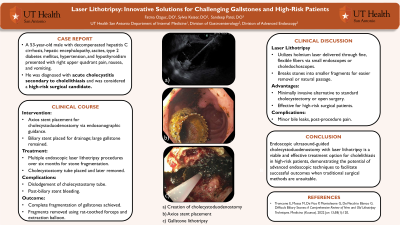Sunday Poster Session
Category: Interventional Endoscopy
P1110 - Laser Lithotripsy: Innovative Solutions for Challenging Gallstones and High-Risk Patients
Sunday, October 27, 2024
3:30 PM - 7:00 PM ET
Location: Exhibit Hall E

Has Audio

Fatma Ozguc, DO
UTHSCSA
San Antonio, TX
Presenting Author(s)
Award: Presidential Poster Award
Fatma Ozguc, DO1, Sylvia Keiser, DO1, Sandeep Patel, DO2
1UTHSCSA, San Antonio, TX; 2University of Texas Health Science Center, San Antonio, TX
Introduction: Laser lithotripsy for cholelithiasis utilizes laser energy to fragment gallstones that are difficult to remove with conventional methods or in patients unsuitable for surgery1. In this report, we present a patient with acute cholecystitis who was not a surgical candidate and underwent laser lithotripsy with successful resolution of the gallstone.
Case Description/Methods: A 53-year-old male with decompensated hepatitis C cirrhosis, hepatic encephalopathy, ascites, type 2 diabetes mellitus, hypertension, and hypothyroidism presented to the emergency room with right upper quadrant pain, nausea, and vomiting. He was diagnosed with acute cholecystitis secondary to cholelithiasis and was considered a high-risk surgical candidate. To facilitate gallbladder drainage, an Axios stent was placed to create a cholecystoduodenostomy after the common wall between the duodenum and the gallbladder was assessed with color Doppler and punctured under endosonographic guidance. Additionally, a biliary stent was placed to aid in drainage, though a large gallstone remained. Over the next six months, the patient underwent multiple endoscopic laser lithotripsy procedures to fragment and remove the gallstones. Eventually, a cholecystostomy tube was placed and later removed. The course was complicated by the dislodgement of the cholecystostomy tube and post-biliary stent bleeding. At the end of the treatment course, complete fragmentation was achieved. The stone fragments were removed with rat-toothed forceps and an extraction balloon.
Discussion: Laser lithotripsy generally employs a holmium laser, which is delivered through fine, flexible fibers through the channels of small endoscopes or choledochoscopes1. This laser energy breaks the stones into smaller fragments, allowing them to be removed or allowed to pass naturally. Complications include minor bile leaks and post-procedure pain1. Laser lithotripsy offers a specialized, minimally invasive alternative to standard cholecystectomy or open surgery, highlighting developments in advanced endoscopy.
[1]Troncone E, Mossa M, De Vico P, Monteleone G, Del Vecchio Blanco G. Difficult Biliary Stones: A Comprehensive Review of New and Old Lithotripsy Techniques. Medicina (Kaunas). 2022 Jan 13;58(1):120.

Disclosures:
Fatma Ozguc, DO1, Sylvia Keiser, DO1, Sandeep Patel, DO2. P1110 - Laser Lithotripsy: Innovative Solutions for Challenging Gallstones and High-Risk Patients, ACG 2024 Annual Scientific Meeting Abstracts. Philadelphia, PA: American College of Gastroenterology.
Fatma Ozguc, DO1, Sylvia Keiser, DO1, Sandeep Patel, DO2
1UTHSCSA, San Antonio, TX; 2University of Texas Health Science Center, San Antonio, TX
Introduction: Laser lithotripsy for cholelithiasis utilizes laser energy to fragment gallstones that are difficult to remove with conventional methods or in patients unsuitable for surgery1. In this report, we present a patient with acute cholecystitis who was not a surgical candidate and underwent laser lithotripsy with successful resolution of the gallstone.
Case Description/Methods: A 53-year-old male with decompensated hepatitis C cirrhosis, hepatic encephalopathy, ascites, type 2 diabetes mellitus, hypertension, and hypothyroidism presented to the emergency room with right upper quadrant pain, nausea, and vomiting. He was diagnosed with acute cholecystitis secondary to cholelithiasis and was considered a high-risk surgical candidate. To facilitate gallbladder drainage, an Axios stent was placed to create a cholecystoduodenostomy after the common wall between the duodenum and the gallbladder was assessed with color Doppler and punctured under endosonographic guidance. Additionally, a biliary stent was placed to aid in drainage, though a large gallstone remained. Over the next six months, the patient underwent multiple endoscopic laser lithotripsy procedures to fragment and remove the gallstones. Eventually, a cholecystostomy tube was placed and later removed. The course was complicated by the dislodgement of the cholecystostomy tube and post-biliary stent bleeding. At the end of the treatment course, complete fragmentation was achieved. The stone fragments were removed with rat-toothed forceps and an extraction balloon.
Discussion: Laser lithotripsy generally employs a holmium laser, which is delivered through fine, flexible fibers through the channels of small endoscopes or choledochoscopes1. This laser energy breaks the stones into smaller fragments, allowing them to be removed or allowed to pass naturally. Complications include minor bile leaks and post-procedure pain1. Laser lithotripsy offers a specialized, minimally invasive alternative to standard cholecystectomy or open surgery, highlighting developments in advanced endoscopy.
[1]Troncone E, Mossa M, De Vico P, Monteleone G, Del Vecchio Blanco G. Difficult Biliary Stones: A Comprehensive Review of New and Old Lithotripsy Techniques. Medicina (Kaunas). 2022 Jan 13;58(1):120.

Figure: a) Creation of cholecystoduodenostomy b) Axios stent placement c) Gallstone lithostripsy
Disclosures:
Fatma Ozguc indicated no relevant financial relationships.
Sylvia Keiser indicated no relevant financial relationships.
Sandeep Patel indicated no relevant financial relationships.
Fatma Ozguc, DO1, Sylvia Keiser, DO1, Sandeep Patel, DO2. P1110 - Laser Lithotripsy: Innovative Solutions for Challenging Gallstones and High-Risk Patients, ACG 2024 Annual Scientific Meeting Abstracts. Philadelphia, PA: American College of Gastroenterology.

